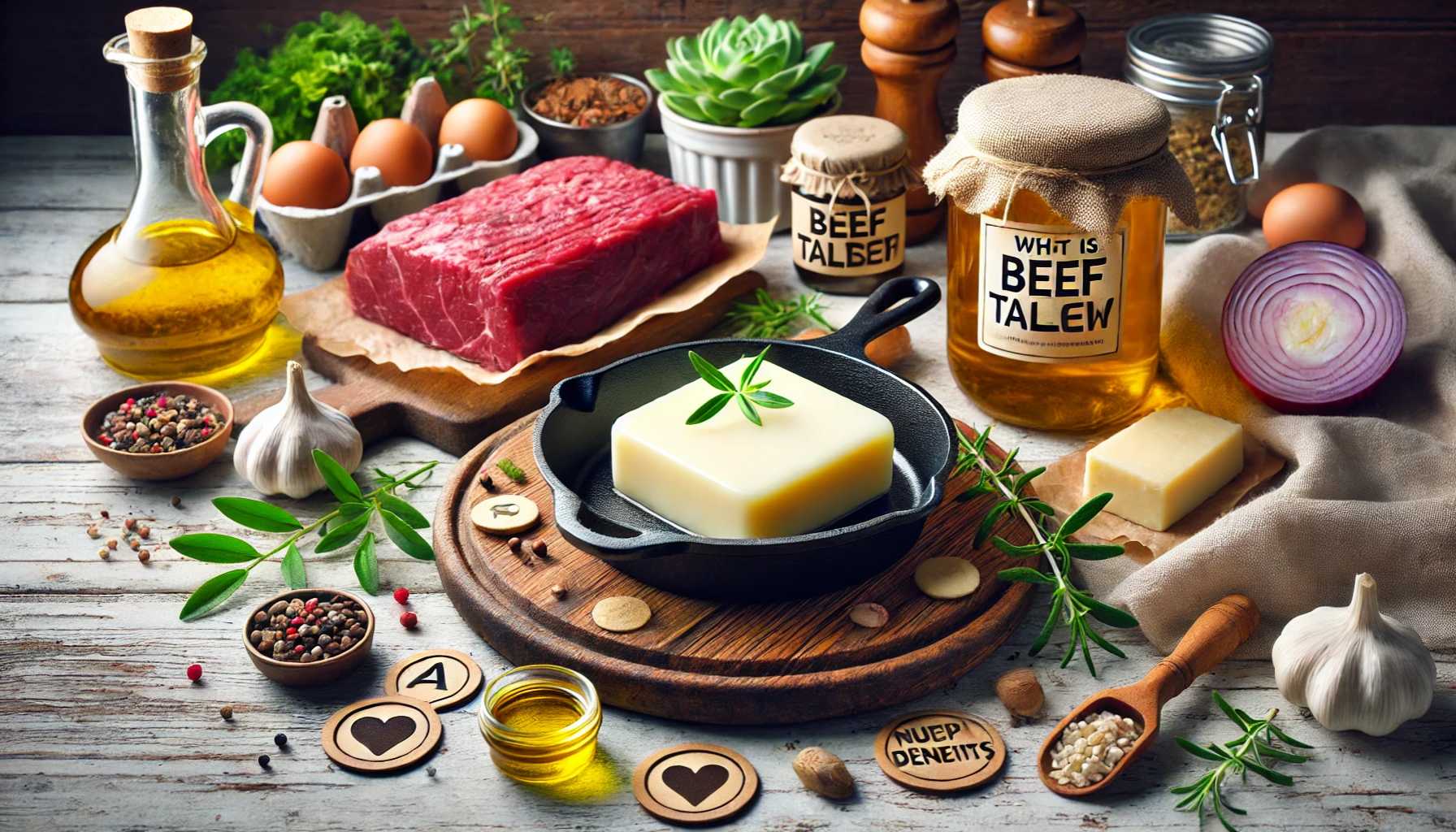Why Beef Tallow is the Best for Cooking and Deep Frying

Once a staple in kitchens worldwide, beef tallow is returning as a preferred cooking fat.
It was known for centuries as a versatile, nutritional, and savory flavored ingredient.
As vegetable oils became popular, tallow went out of fashion.
These days we’re learning more about the health and sustainability benefits of traditional fats, and beef tallow has made a comeback as a powerful ingredient in cooking and deep frying.
This guide will examine what makes beef fat great for many cooking methods.
Beef tallow has a high smoke point and a different flavor, making it a great alternative to conventional oils when added to dishes.

What is Beef Tallow?
Beef tallow is just fat from beef that’s been rendered.
It's made by cooking down beef fat, usually around the kidneys until it becomes a liquid.
Once rendered, it becomes a rich, smooth, white substance that solidifies as it cools and is healthy in fat.
Tallow is unlike other fats in that its mix of saturated and monounsaturated fats offers it unique shelf stability and solidifies at room temperature.
Its high smoke point also comes from this balance, and it's excellent for frying and roasting.
Beef tallow is the beef-based version of lard, which many people are familiar with, but comes from pork.
Beef tallow is an animal fat, but it has a unique flavor profile that is ideal for savory dishes.
Until processed vegetable oils started selling in large volumes, this was one of the most common cooking fats used in history.
The Benefits of Cooking with Beef Tallow
Safer Cooking: High Smoke Point
Beef tallow's high smoke point—around 400°F (204°C)—is one of its distinguishing features. (1)
It’s much higher than that of many oils, like olive oil or butter, which means tallow can take heat without breaking down.
If oils are heated past their smoke point, they can release dangerous compounds and have an unpleasant taste.
Tallow’s stability at high temperatures makes it an excellent choice for deep frying, pan searing, and roasting, with a cleaner, safer cooking experience.

Nutrient Density and Health Benefits
Beef tallow is not just a cooking fat; it’s also a nutrient-dense food.(2)
Packed with fat-soluble vitamins like vitamins A, D, E, and K, these vitamins are crucial to overall health and are frequently lacking in our modern diets.
Conjugated linoleic acid (CLA) is a type of fat found in tallow.
It has been studied as a potential anti-inflammatory and immune-boosting fat. (3)
Research continues, but studies have demonstrated that CLA may aid weight management and support heart health.
Beef tallow is a more natural fat than heavily processed vegetable oils and contains fewer additives. (4)
Tallow is an excellent choice if you want a more spartan diet and do not want to consume processed oils.
Adding nutrient-dense supplements to your routine can further support daily health and complement the benefits of cooking with wholesome ingredients like beef tallow.
Adding Flavor to Your Dishes
The flavor beef tallow imparts is another reason to use it in cooking.
Although tallow gives a deep, savory richness, it can elevate simple dishes.
It's milder than butter but stronger than vegetable oils, making it just right for adding flavor to foods in their most natural form.
Using tallow will provide some extra punch to fried or roasted dishes without dominating the other flavors.
Chefs often recommend beef tallow for its enhanced depth of flavor in fried potatoes, vegetables, or breaded meats.

Natural and Sustainable Cooking Option
Tallow is also more sustainable than many plant-based oils. (5)
It’s a beef byproduct, so it’s a type of upcycling within the food industry.
Instead of throwing the fat away, it’s converted into a functional, nutritious product.
Producing tallow has a lower environmental impact than vegetable oils, such as palm oil, which can involve deforestation and large land and water uses.
Using tallow is a more holistic and sustainable way of cooking.
Cooking With Beef Tallow
Sautéing and Pan-Frying
Because of its stable structure, beef tallow is the perfect fat for sautéing and pan-frying.
To use it for sautéing, melt it in a pan over medium heat.
You can add your vegetables, meat, or grains to the pan if you melt them.
Tallow’s gentle flavor goes well with many foods and doesn’t overwhelm the taste of your ingredients.
To pan fry, use a bit more tallow than you would for oil frying so the food is evenly coated.
Meats, eggs, and some baked goods are okay with this method.
Deep Frying with Beef Tallow
Deep frying is a great way to use beef tallow.
It has a high smoke point and won’t degrade quickly, even after long-term use at high temperatures.
Thus, it’s both safe and economical for frying.
When deep frying, heat the fat to about 350-375°F (175-190°C), depending on the food you’re cooking.
Ensure your food is fully submerged in the melted fat and cook until golden brown.
When you’re finished frying, let the tallow cool, strain it, and save it for use again.
Roasting and Baking
Beef tallow is a great ingredient for roasting, adding extra flavor and richness to meats, vegetables, and even baked goods.
Just melt the tallow and coat your ingredients before putting your dish in the oven.
Tallow can be used in place of butter or shortening in some recipes for baking.
In savory dishes like meat pies or biscuits, you want a rich flavor but not a sweet butter flavor, so it’s beneficial.
Beef Tallow vs. Other Cooking Fats
But when we compare beef tallow to vegetable oil, grease wins out on stability, flavor, and sustainability.
Highly refined vegetable oils, such as soybean and canola oil, are processed with great intensity, removing nutrients.
Furthermore, vegetable oils have a lower smoke point than tallow, meaning that cooking them at high temperatures tends to break them down and create unhealthy compounds.
Beef fat is often the superior choice for those who are looking for beef flavor and health benefits.
Butter vs. Beef Tallow vs. Olive Oil
Butter and olive oil are the most popular cooking mediums, but tallow is more versatile.
Because butter is low in smoke point, it’s perfect for baking and light sautéing but not for high-heat cooking.
Healthy olive oil has a medium smoke point and will break down at higher temperatures.
Tallow is so able to stand up to high heat that it’s not only a great frying oil but also a great roasting oil, where butter and olive oil may not fare so well.
How to Render and Store Beef Tallow
Home rendering of beef tallow is simple: raw beef fat is heated until it melts.
First, cut the beef fat into small pieces. Put it in a pot and heat over low heat until melted slowly.
Once the fat has completely melted, strain it through cheesecloth to remove any impurities.
To solidify, cool the liquid tallow in a clean container.
Storing homemade tallow in an airtight container in the fridge or freezer will keep it for a longer shelf life.
When stored properly, tallow will last several months.
It’s a great fat to have on hand, naturally stable, whether you’re cooking with it or adding it to a dish.
Upgrade your pantry with sustainable and traditional fat.
Wild Foods Beef Tallow adds flavor, nutrients, and value to every meal.
Final Thoughts
Beef tallow is a great cooking fat with a long history, plenty of versatility, and health-supporting nutrients.
Its high smoke point and natural stability make it the perfect oil for cooking and deep frying, and it adds a depth of flavor to your meals.
If you’re interested in adding traditional and sustainable fat to your kitchen, beef tallow strikes a perfect balance of nutrition and culinary value.
Beef tallow can add a savory note to your cooking, whether you’re roasting vegetables, deep frying, or baking goods.
Try it, and you’ll taste the difference natural fat can make.
FAQWhat is beef tallow good for?
Beef tallow is a great cooking fat because its smoke point is high and its fat composition is stable.
It’s versatile and adds a nice rich flavor to dishes.
Is beef tallow better than vegetable oil?
Many consider beef tallow a healthier option than heavily refined vegetable oils because it is less refined and contains beneficial fats like CLA and fat-soluble vitamins.
Can you deep fry with beef tallow?
Absolutely. Deep frying with tallow offers crispness and a more flavorful finish because of its high smoke point.
For how long does beef tallow last?
Finally, beef tallow is a long-lasting cooking fat. When stored properly in the refrigerator or freezer, it can last for months.
Is beef tallow strongly flavored?
Beef tallow has a savory, mild flavor that won’t overpower your food. It’s not as intense as lard or butter, so it’s perfect for many dishes.
Related Studies
Title: The Effect of Partial Substitution of Beef Tallow on Selected Properties of Beef Burgers
Summary: This study analyzes the vitamin content and health effects of beef tallow, emphasizing its fatty acid profile and implications for immunity and general well-being.
Link: https://pmc.ncbi.nlm.nih.gov/articles/PMC9266241/
Title: Influence of Heating during Cooking on Trans Fatty Acid Content of Edible Oils
Summary: This research explores how high smoke point fats, including beef tallow, affect trans fatty acid formation during cooking, highlighting their stability and health implications.
Link: https://pmc.ncbi.nlm.nih.gov/articles/PMC9002916/
Title: Conjugated Linoleic Acid and Its Beneficial Effects in Obesity
Summary: This study summarizes the anti-inflammatory benefits of CLA, its role in cardiovascular health, and its potential for weight management.
Link: https://pmc.ncbi.nlm.nih.gov/articles/PMC7401241/
Title: Conjugated Linoleic Acid Effects on Cancer, Obesity, and Atherosclerosis
Summary: This review compares the health impacts of beef tallow and vegetable oils, particularly focusing on their effects in high-heat cooking contexts and overall human health.
Link: https://pmc.ncbi.nlm.nih.gov/articles/PMC6413010/
Title: Comparative Life Cycle Assessment of Palm Oil and Beef Tallow Production
Summary: This study evaluates the environmental impacts of beef tallow production compared to palm oil, focusing on sustainability practices and deforestation issues.
Link: https://www.ncbi.nlm.nih.gov/pmc/articles/PMC7401241/

